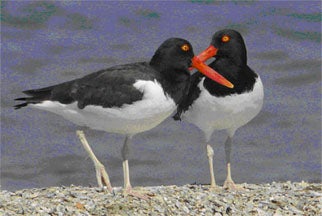OTHER NAMES:
Brown-backed Oystercatcher.
STATUS:
Breeder. Fairly common in Gulf Coast region (mostly Mobile County) in all seasons. HIGHEST CONSERVATION CONCERN.
DESCRIPTION:
American oystercatcher (Haematopus palliatus) is a relatively large (16-17 in.),boldly marked shorebird with a black head, dark brown or black back, and white breast, flanks, and belly. The bill is laterally compressed, bright red to orange with a yellow tip. The eye is distinct with a yellow iris and red eye ring, and legs are pale pink. Juvenile oystercatchers are browner than adults, with a dark iris, dull grayish legs, and dark tipped pinkish brown bill. An oystercatcher’s call is a loud kleep; alarm call is a ringing wip given with increasing frequency as danger nears nest or young. There are five races of American oystercatcher recognized, and two, H. p. palliatus and H. p. frazeri, are found in North America. Only theH. p. palliatus occurs in Alabama.
DISTRIBUTION:
Haematopus palliatus palliatus breeds along the Atlantic Coast from Massachusetts south to Indian River County in Florida, and along the Gulf Coast from north of the Everglades westward to Texas, and south to the Yucatan Peninsula in Mexico. The western race, H. p. frazeri, breeds from both Baja, California, coasts southward to South America on the Pacific Coast. In winter, birds breeding north of Virginia migrate south. In Alabama, theAmerican oystercatcher is a year-round resident of coastal Mobile County but is rarely seen in Baldwin County. Birds nest on coastal islands including Dauphin Island, Little Dauphin Island, Pelican Island, Cat Island, and Isle Aux Herbes. Occasional nesting occurs along the mainland shores in Mobile County where habitat permits. Population of American oystercatcher in Alabama is less than 50 birds.
HABITAT:
A coastal species, American oystercatcher inhabits sand and shell beaches. Salt marshes, mudflats, and dredge spoils are also used.
FEEDING HABITS:
Oystercatchers probe tidal flats for bivalves and other invertebrates. Major food items include oysters, ribbed mussels, razor clams, other bivalves, and marine crustaceans and invertebrates. When feeding on bivalves, an oystercatcher will thrust its bill between open valves to sever the adductor muscles which hold valves closed. Once the adductor muscles are severed, the oystercatcher will separate the valves and eat soft parts.
LIFE HISTORY AND ECOLOGY:
American oystercatcher is typically monogamous. Both sexes, butmost often the male, construct a nest scrape, which is typically a shallow depression in sand or shell with nothing added. Two to three buff to olive eggs marked with spots and blotches of brown or black arelaid in April. Only onebrood israised per season, but a replacement clutch can be laid if a clutch is lost. Incubation by both parents lasts around 26 days. Chicks follow adults around after synchronous hatching and are dependent on adults for two months. Young birds may not breed until three years of age.
REFERENCES:
Marchant, J., T. Prater, and P. Hayman. 1986. Shorebirds, an identification guide. Houghton Mifflin Co., Boston, MA. 412 pp.
Nol, E., and R. C. Humphrey. 1994. American oystercatcher (Haematopus palliatus).
A. Poole and F. Gill, eds. The birds of North America. No. 82. The birds of North America, Inc., Philadelphia, PA.
Author: Roger Clay, Alabama Nongame Wildlife Program






